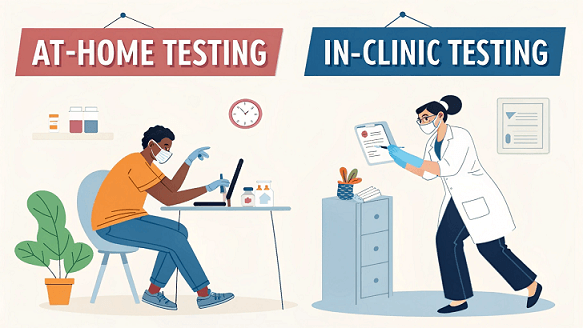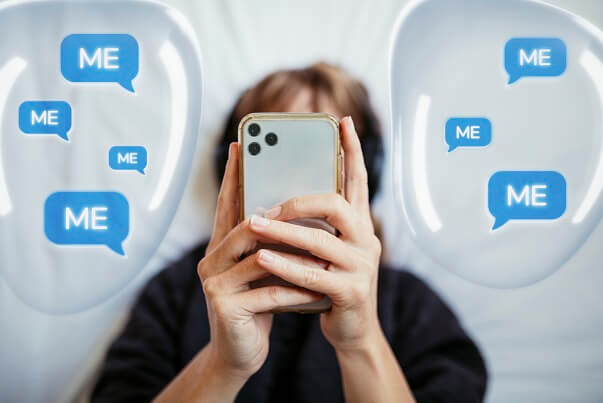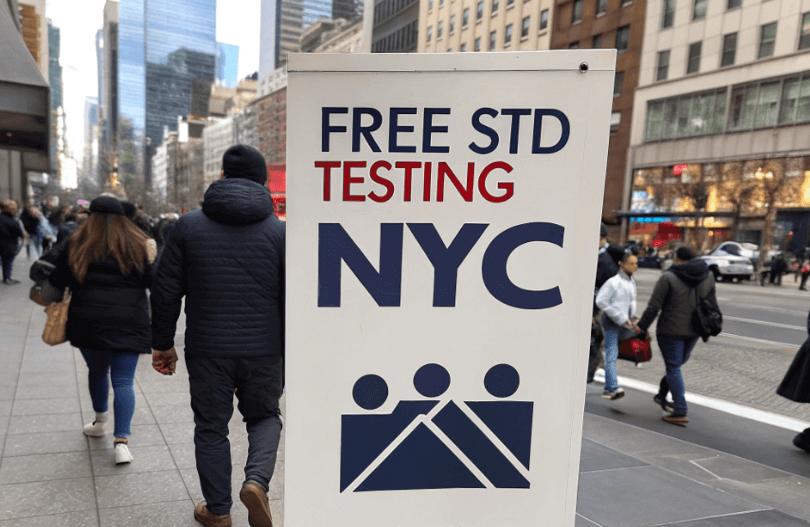Seamos honestos, existen dos tipos de miedo para alguien que sospecha tener una ETS. El primero es el miedo a entrar a la clínica. El segundo es el miedo a hacerse la prueba y abrir los resultados. Ambos son completamente normales, y esto es para que sepas que no eres el único que se siente así. Al igual que tú, todos los que han visto señales o sentido algún síntoma tienen esta sensación al ir a la clínica.
La buena noticia es que existen maneras prácticas de lidiar con la ansiedad por ETS, incluso antes y después de las pruebas. En esta publicación, te guiaremos a través de todo el proceso, brindándote herramientas con estrategias mentales y emocionales para cada paso.
¿Cómo afrontar la ansiedad previa a la prueba sobre las ETS?
¿Te da miedo pedir cita para hacerte la prueba? ¿Te preocupa lo que pueda pasar si el resultado es positivo? No deberías. Lo cierto es que, cuanto más sabes, menos miedo y ansiedad hay.
Aquí hay algunos datos y planes que pueden ayudarle a lidiar mejor con la ansiedad por ETS:
3 verdades para anclar tu mente
- Verdad 1: La mayoría de las ITS son tratables y manejables. Gracias a Dios por la medicina moderna: es extraordinaria. Cuando consultes con un experto médico, descubrirás que muchas ITS comunes como Gonorrea y Clamidia son curables con un simple tratamiento de antibióticos. Otras como Herpes y VIH Son muy manejables con medicamentos, lo que permite que las personas vivan vidas largas, saludables y felices.
- Verdad 2: No saber es peor que saber. La ansiedad por ETS solo crece en la incertidumbre. No actuar y llenarte la mente de "qué hubiera pasado si..." solo te quitará energía. Evitar las pruebas por el posible resultado solo prolonga la incertidumbre y empeora tu ansiedad. Por lo tanto, necesitas hacerte la prueba sin darle demasiadas vueltas al resultado. Reemplaza el miedo con hechos y date la fuerza para actuar.
- Verdad 3: Eres parte de una gran comunidad. Quizás te interese saber que millones de personas se hacen pruebas de ITS cada año. Las infecciones de transmisión sexual son más comunes de lo que crees. Pero lo que mucha gente hace es hacerse la prueba a tiempo y buscar tratamiento. Esto es parte normal y responsable de la atención médica moderna (al igual que un chequeo médico regular).

Plan de acción previo a la prueba
- Programar la prueba Ahora: La acción más empoderadora que puedes tomar es programar la cita. No te dejes llevar por el miedo. Saber si eres positivo o no te convierte en alguien que se preocupa pasivamente y busca activamente la solución de problemas.
- Entender el proceso: Antes de ir al médico, recuerde hacer preguntas (no sea tímido ni le dé vergüenza). Pregunte, por ejemplo, si se trata de una prueba de sangre, orina o hisopado. ¿Cuánto tiempo tardarán los resultados? Conocer el proceso de la prueba elimina el miedo a lo desconocido.
- Reúne tu sistema de apoyo: Es recomendable que vayas con un amigo o familiar tranquilo y sin prejuicios. La ansiedad podría aparecer en algún momento; podrías necesitar ayuda adicional para controlarla. Simplemente envía un mensaje conciso pero elaborado como este a tu red de apoyo: "Hola, me estoy haciendo un chequeo médico que me está causando ansiedad. ¿Podrías acompañarme para darme apoyo moral? Podemos tomar un café después".

En la sala de espera: un kit de herramientas de 2 minutos para la ansiedad
- La técnica de la “respiración de caja”: Algunos de los síntomas de ansiedad por ETS se notan en la sala de espera (se empieza a sentir intranquilo e incluso se puede empezar a caminar de un lado a otro o a golpear el suelo con los pies). En esta situación, puede aplicar esta sencilla técnica para calmarse: Inhale durante 4 segundos, contenga la respiración durante 4 segundos, exhale durante 4 segundos y contenga la respiración durante 4 segundos. Repita el proceso hasta que se calme. Esta técnica está científicamente comprobada para calmar el sistema nervioso.
- Distracción a pedido: Otra forma de controlar la ansiedad en la sala de espera es desviar la atención a algo que te guste. Por ejemplo, puedes escuchar tu música favorita, podcasts, ver vídeos divertidos de YouTube o jugar a algo en tu teléfono. No te quedes sin rumbo; ten preparada una distracción específica de antemano.

Cómo abordar los resultados y emociones del POST-TEST
¿Te has hecho la prueba y ya tienes los resultados? ¿Es negativo o positivo? No te preocupes; te explicamos qué hacer a continuación.
Escenario A: Tu resultado es negativo. ¿Y ahora qué?
¡Felicidades! Ya puedes respirar, sobre todo después del miedo que sentías antes de hacerte la prueba. Lo que hiciste fue pura valentía. Es normal sentir un inmenso alivio.
Pero a veces, la ansiedad regresa y te susurra: "¿Y si se les escapó algo?". Esta sensación es común, sobre todo porque el cuerpo humano tiende a pensar en lo peor en situaciones como esta. Lo mejor que puedes hacer es recordar que confiaste en un profesional médico y en una prueba científica, y que crees que el resultado es negativo. Canaliza esta energía residual en acciones positivas para el futuro.
Ahora que has dado negativo en la prueba, asegúrate de evitar cualquier actividad sexual que pueda perjudicar tu salud. Crea un plan sobre Prevención de ITS para tener relaciones sexuales más seguras Y chequeos regulares para mantener esta tranquilidad. Use protección, como condones, antes de tener relaciones sexuales.
Escenario B: Su resultado es positivo. Una guía amable para la próxima hora.
Respira lenta y profundamente. No hay necesidad de entrar en pánico. Como se mencionó anteriormente, las ETS son tratables y controlables. No son el fin de la vida, así que no des por sentado que estás perdido. Debes darte cuenta de que eres la misma persona que eras hace un minuto. De hecho, ahora estás mejor porque sabes que tu salud está en orden, y "el conocimiento es poder".
Entendemos que en situaciones como esta es difícil procesar la información, sobre todo porque estás en shock. Lo que puedes hacer es documentar toda la información que necesitas. Escucha el consejo del experto médico y el siguiente paso. Es muy probable que olvides lo que te digan, así que anótalo. Anota el nombre de la ITS, los medicamentos que tomarás, el plazo del tratamiento, tu próxima cita y demás información.
En esta etapa, las palabras de afirmación son muy importantes. Repítete: «Esto es manejable. Esto es tratable. Voy a estar bien». Repítelo. Incluso puedes escribir estas palabras en un papel y pegarlas en la pared de tu habitación para decirlas cada vez que el miedo te invada. Estas palabras son ciertas; créelas.
Lo siguiente es planificar tus próximos pasos (no toda tu vida). Una ETS no significa que tu vida se acabe; hay medicamentos que te harán sentir mejor. ¿Qué sigue? Empieza por usar tu medicación según lo recetado por el médico. Cuéntaselo a un amigo o familiar de confianza para que te ayude a levantarte la moral. Simplemente concéntrate en mejorar y en mantener la mentalidad adecuada día a día.
En algún momento, tendrás que notificar a tus parejas sexuales (pasadas y actuales), ya sea por texto o por teléfono, para que también puedan hacerse la prueba y recibir tratamiento (si dan positivo). Tenemos una guía paso a paso sin prejuicios sobre Cómo notificar anónimamente a una pareja aquí.
Bienestar a largo plazo: Cómo afrontar la ansiedad por las ETS
A continuación se ofrecen algunos consejos profesionales para afrontar un diagnóstico de ETS y la ansiedad:
- Practica la autocompasión, no la culpa: Háblate como le hablarías a un buen amigo en la misma situación. No te castigues ni te desanimes. Date palabras de ánimo y haz cosas divertidas que te animen.
- Desestigmatiza tu propio pensamiento: Tenga en cuenta que una ETS es una condición de salud, no un defecto moral. Incluso la persona que usted considera más moralmente correcta puede contraer una ETS. Así que despreocúpese de su estado de salud.
- Busque apoyo profesional en salud mental: Si te cuesta lidiar con la ansiedad por ETS y esta está afectando tu vida, deberías hablar con un terapeuta. Este te puede brindar herramientas más profundas para gestionar estos sentimientos a largo plazo.
Conclusión
La ansiedad por ETS es una carga pesada, pero se puede aliviar. Al dividir el proceso de cómo lidiar con la ansiedad por ETS en pasos pequeños y manejables y al tratarte con amabilidad, puedes pasar del miedo a un estado de empoderamiento.
Recuerda, eres responsable, eres valiente y eres capaz de manejar esto.

 Anonsms
Anonsms
 Caballero
Caballero




